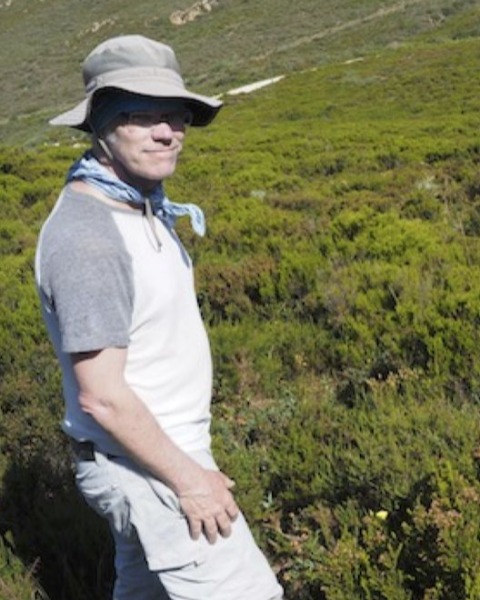Back
Contributed Poster
Poster Type: Contributed Poster
Poster Session:: Communities: Traits And Functional Diversity
PS 14-138 - Mechanisms of fire-maintained plant species diversity in wet pine savannas
Monday, August 15, 2022
5:00 PM – 6:30 PM EDT
Located in: ESA Exhibit Hall

Stephen Brewer
University of Mississippi
University, Mississippi, United States
Presenting Author(s)
Background/Question/Methods
Fire-maintained pine savannas of the Coastal Plain of the southeastern USA contain extraordinarily species-rich communities of endemic plants. How frequent fires maintain such diversity is largely unstudied. This study examined the effects of the frequency of simulated fire (clipping combined with litter removal) on species diversity and trait and species composition within twenty 2 × 2 m plots at each of two pine savannas in southeastern Mississippi (USA). Following a clipping treatment in fall 2019, four (0.25 × 0.25 m) quarter plots were established within each of 10 plots per site that had been clipped annually from 2014 to 2019 and in 2021 and assigned a 2 × 2 factorial arrangement of transplantation of sods from long-unburned areas and herbicide application. A comparison of the effects of simulated fire and herbicide provided a test of the relative importance of recruitment and persistence on diversity and composition. The other 10 clipping plots were not clipped from 2018 to 2020. A 0.25 × 0.25 m subplot was established within each plot in August 2021 and compared with quarter plots within the annually-clipped plots to test the effects of a short period without clipping on diversity and composition.
Results/Conclusions
Transplanted sods had lower species richness than did annually-clipped, non-transplanted controls in the first growing season (2020) at the more species-rich site (Sandy Creek). There was a slight trend towards recovery of species diversity in transplanted quarter plots by the second season (2021). At the other site (Grand Bay), species diversity was not significantly lower in transplanted sods than in annually-clipped, non-transplanted controls in either year. A comparison with the effects of the herbicide revealed that partial or complete recovery of diversity at both sites was driven by rapid increases in short-lived, resilient species that show fire-stimulated emergence from a seed bank (e.g., Drosera capillaris) and the persistence of long-lived species capable of surviving the prolonged period without fire or clipping (e.g., Aristida beyrichiana, Muhlenbergia expansa). Species with an intermediate life history recovered slowly following a prolonged period without fire or clipping. Plots that were not clipped from 2018 to 2020 were associated with lower species diversity, largely driven by a lack of species with intermediate life history strategies. Results are consistent with a model of coexistence of resilient, intermediate, and persistent strategies maintained by the most frequent fire regimes fuels will permit.
Fire-maintained pine savannas of the Coastal Plain of the southeastern USA contain extraordinarily species-rich communities of endemic plants. How frequent fires maintain such diversity is largely unstudied. This study examined the effects of the frequency of simulated fire (clipping combined with litter removal) on species diversity and trait and species composition within twenty 2 × 2 m plots at each of two pine savannas in southeastern Mississippi (USA). Following a clipping treatment in fall 2019, four (0.25 × 0.25 m) quarter plots were established within each of 10 plots per site that had been clipped annually from 2014 to 2019 and in 2021 and assigned a 2 × 2 factorial arrangement of transplantation of sods from long-unburned areas and herbicide application. A comparison of the effects of simulated fire and herbicide provided a test of the relative importance of recruitment and persistence on diversity and composition. The other 10 clipping plots were not clipped from 2018 to 2020. A 0.25 × 0.25 m subplot was established within each plot in August 2021 and compared with quarter plots within the annually-clipped plots to test the effects of a short period without clipping on diversity and composition.
Results/Conclusions
Transplanted sods had lower species richness than did annually-clipped, non-transplanted controls in the first growing season (2020) at the more species-rich site (Sandy Creek). There was a slight trend towards recovery of species diversity in transplanted quarter plots by the second season (2021). At the other site (Grand Bay), species diversity was not significantly lower in transplanted sods than in annually-clipped, non-transplanted controls in either year. A comparison with the effects of the herbicide revealed that partial or complete recovery of diversity at both sites was driven by rapid increases in short-lived, resilient species that show fire-stimulated emergence from a seed bank (e.g., Drosera capillaris) and the persistence of long-lived species capable of surviving the prolonged period without fire or clipping (e.g., Aristida beyrichiana, Muhlenbergia expansa). Species with an intermediate life history recovered slowly following a prolonged period without fire or clipping. Plots that were not clipped from 2018 to 2020 were associated with lower species diversity, largely driven by a lack of species with intermediate life history strategies. Results are consistent with a model of coexistence of resilient, intermediate, and persistent strategies maintained by the most frequent fire regimes fuels will permit.
